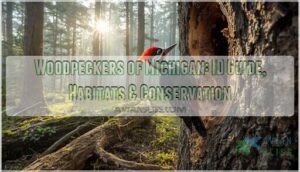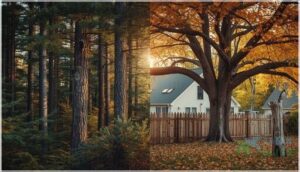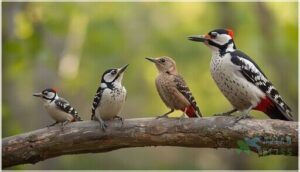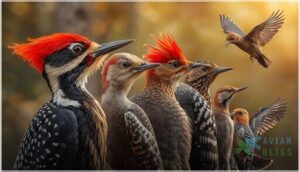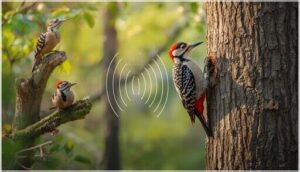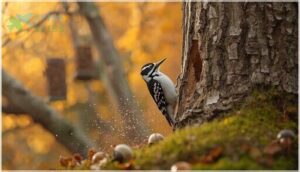This site is supported by our readers. We may earn a commission, at no cost to you, if you purchase through links.
The staccato drumming echoing through Michigan’s forests isn’t random—it’s a precisely timed territorial broadcast that can identify a woodpecker species as reliably as a fingerprint. Michigan hosts eight distinct woodpecker species, each occupying its own ecological niche, from the crow-sized pileated drilling into old-growth timber to the sparrow-sized downy working suburban feeders.
These birds aren’t just charismatic residents; they’re ecosystem engineers, excavating cavities that dozens of other species depend on for shelter. Understanding the woodpeckers of Michigan means learning to read subtle differences in size, plumage patterns, and behavior—skills that transform a walk through the woods into a detective game.
Whether you’re trying to distinguish a hairy from a downy or wondering why that flicker spends so much time on the ground, recognizing these species opens up a deeper connection to Michigan’s forests and the conservation challenges they face.
Table Of Contents
- Key Takeaways
- Common Woodpecker Species in Michigan
- Woodpecker Habitats Across Michigan
- How to Identify Michigan Woodpeckers
- Woodpecker Behavior and Diet
- Conservation of Michigan’s Woodpeckers
- Frequently Asked Questions (FAQs)
- Are there woodpeckers in Michigan?
- Where are pileated woodpeckers found in Michigan?
- Are red-bellied woodpeckers common in Michigan?
- Do woodpeckers eat trees in Michigan?
- Where do golden-fronted woodpeckers live in Michigan?
- Do woodpeckers migrate to Michigan?
- What is the most common woodpecker in Michigan?
- What bird looks like a woodpecker but isn’t?
- Are woodpeckers good to have in your yard?
- What does it mean if you see a pileated woodpecker?
- Conclusion
Key Takeaways
- Michigan hosts eight distinct woodpecker species that function as ecosystem engineers by excavating cavities used by over 80 other species for shelter, while their foraging controls beetle populations and drives nutrient cycling through forests.
- You can distinguish woodpecker species through a combination of size (ranging from 5.5-inch Downys to 16-inch Pileateds), bill length, plumage patterns, drumming rhythms (varying from 2.5–7 kHz depending on species), and foraging behavior like the Northern Flicker’s ground-feeding or Yellow-bellied Sapsucker‘s sap well drilling.
- Habitat fragmentation has reduced mature forest territories by 43% over 25 years, while pesticide use cuts beetle prey by up to 27% in agricultural zones—making conservation efforts like increasing snag retention and protecting cavity trees during timber harvests critical for population survival.
- Most Michigan woodpeckers are year-round residents rather than migrants, with species like Downys and Hairies readily adapting to suburban environments and backyard feeders when mature trees and deadwood remain available.
Common Woodpecker Species in Michigan
Michigan’s forests and backyards host a surprising variety of woodpeckers, from tiny Downys to crow-sized Pileateds. Each species has its own signature look and behavior that makes identification easier once you know what to watch for.
Here’s a closer look at the eight woodpeckers you’re most likely to encounter across the state.
Downy Woodpecker Identification
You’ll spot the Downy Woodpecker by its compact six-to-seven-inch frame and stubby chisel-shaped beak—shorter than its head. Feather colors include crisp black-and-white checkered wings and a pale belly. Males flash a tiny red patch on the crown. Look for tail spots with white outer feathers and listen for its high-pitched peep.
This species thrives in Michigan’s deciduous woods and backyards year-round, making woodpecker identification straightforward.
Hairy Woodpecker Features
The Hairy Woodpecker looks similar but runs larger—about nine inches—with a bill length nearly matching its head width. You’ll notice the same black-and-white checkered feather patterns, though the plumage variation shows sharper contrast. Males carry that red patch on the nape.
Key differences for woodpecker identification:
- Bill structure is stout and chisel-like, measuring 14–17 mm
- Head colors feature bold white crown extending to nape
- Beak structure appears noticeably longer than Downy’s stubby bill
Understanding species through research network tools can aid in accurate woodpecker identification.
Red-bellied Woodpecker Traits
You’ll recognize Red-bellied Woodpeckers by their striking black-and-white barred backs rather than those subtle red belly markings that inspired their name. Males sport a red cap stretching from bill to nape, while females show gray crowns—helpful for sex differentiation during bird identification.
These 9–10-inch woodpeckers display distinctive woodpecker beak shape adapted for rapid tapping. Juveniles feature yellowish-green crowns without fully developed plumage, making them easier to distinguish across Michigan woodpecker habitats.
Understanding AP study resources can help students learn about various species and their habitats.
Northern Flicker Characteristics
Northern Flickers stand out among Michigan’s woodpeckers with their ground-foraging habits and distinctive markings. You’ll notice their 11–12-inch frames sporting spotted bellies, black bibs, and yellow underwing feathers during flight—key features for bird identification.
Here’s what sets them apart:
- Rolling “wick-up” calls and rhythmic drumming patterns during breeding season
- Ant-heavy diet supplemented by beetles and wood-boring larvae
- Short-distance flicker migration with many staying year-round in southern Michigan
- Strong preference for mature trees and dead snags in woodpecker habitats
- Cavity-nesting behavior requiring 5–8 eggs per clutch
Understanding flicker behavior helps support broader bird conservation efforts.
Pileated Woodpecker Description
The Pileated Woodpecker ranks as Michigan’s largest woodpecker species, reaching crow-size dimensions of 15.8–19.3 inches. You’ll recognize this impressive bird by its triangular red crest, bold white neck stripes, and mainly black plumage.
Males display a distinctive red mustache stripe, while females show black in this area—key identification markers when observing these splendid birds in mature forest habitats across the state.
Red-headed Woodpecker Distinct Features
The Redheaded Woodpecker stands out with its striking all-red head and neck—unlike any other Michigan woodpecker species. You’ll spot this bird by its bold black-and-white wing pattern and crisp white underparts, making bird identification straightforward year-round.
- Red head coloration covers the entire head and neck uniformly
- Feather patterns show stark black mantle contrasting with bright white wing patches
- Beak structure measures 18–23 mm in adults for efficient insect extraction
- Woodpecker calls include harsh, repetitive notes and sharp “kent” alarm sounds
- Nesting habits utilize cavities in dead trees across Michigan’s woodlands
Yellow-bellied Sapsucker Unique Traits
You’ll identify the Yellowbellied Sapsucker by that distinctive yellow wash across its belly and bold black-and-white stripes on its face and back. This woodpecker species stands out among Michigan’s woodpeckers through its unique sap-feeding behavior—drilling neat rows of wells into maples and birches.
Bird identification becomes easier when you notice its slender, chisel-like bill and pale throat patch. Conservation status remains stable across woodpecker habitats, though preserving mature deciduous stands fosters healthy populations throughout Michigan’s forests and suburban areas.
| Trait | Yellow-bellied Sapsucker | Similar Woodpeckers |
|---|---|---|
| Tree Selection | Maples, birches for sap wells | Dead/dying wood primarily |
| Foraging Strategies | Sap extraction, insect capture at wells | Bark excavation for larvae |
| Nesting Habits | Excavates cavities in decaying trees | Similar cavity use patterns |
Black-backed and Three-toed Woodpeckers
You’ll rarely spot Black-backed and American Three-toed Woodpeckers in Michigan—they’re specialists tied to beetle outbreaks and burned conifer forests. Habitat fragmentation threatens both species, though conservation strategies focus on retaining snags after fires.
Their woodpecker behavior centers on excavating beetle-killed spruces, with limited woodpecker migration patterns. Forest regeneration efforts and protecting deadwood corridors support these elusive woodpecker habitats across Michigan’s northern reaches.
Woodpecker Habitats Across Michigan
Michigan’s woodpeckers don’t just stick to one type of environment—they’ve carved out niches across the state’s diverse landscapes. From dense northern forests to suburban backyards, each species finds its preferred hunting grounds based on food availability and nesting needs.
Here’s where you’re most likely to spot these birds across Michigan’s varied terrain.
Deciduous and Mixed Forests
Deciduous and mixed forests form the backbone of woodpecker habitats across Michigan, supporting the highest biodiversity conservation values you’ll find statewide.
These woodland habitats offer critical cavity availability in mature trees and abundant deadwood snags—essential ecosystem services for forest wildlife.
Woodland ecology here hinges on tree species composition and woodland management practices that maintain aging timber, directly influencing foraging success and nesting opportunities for most Michigan woodpeckers throughout the year.
Pine and Coniferous Woodlands
Pine ecosystems across Michigan’s 4.5 million acres create specialized woodland habitats where black-backed and pileated woodpeckers thrive in mature conifer stands aged 80–120 years. Understanding tree cavity dynamics in these forest habitats helps you spot wildlife in Michigan’s northern zones:
- Conifer thinning regimes boost mid-successional cavity availability
- Forest fire ecology drives post-burn regeneration within 5–15 years
- Red-cockaded woodpecker species in Michigan favor dense white pine canopies
- Late spring foraging peaks in jack pine communities
- Woodland management experiments (2010–2020) increased nest initiation rates substantially
Dead and Burnt Tree Environments
After forest fires sweep through Michigan’s woodland ecosystems, you’ll find black-backed and pileated woodpeckers thriving in burnt tree habitats where deadwood management becomes nature’s work.
Post-fire ecology creates ideal woodpecker nesting sites—fire regeneration leaves standing snags functional for up to 20 years, with black-backed woodpeckers showing 60% higher occupancy in these transformed forest habitats where insect prey explodes.
Suburban Parks and Backyards
You don’t need untouched wilderness to spot woodpeckers in Michigan—your own yard habitat and suburban trees work just fine. At least four species show up regularly in urban woodland and park management areas, with downy woodpeckers making up nearly half of backyard feeders visits.
Bird watching in Michigan gets easier when you maintain mature trees and deadwood, supporting wildlife conservation in Michigan while boosting woodpecker habitat right outside your window.
Wetlands and Riparian Zones
Wetland ecology shapes bird conservation in unexpected ways—five woodpecker species depend on these riparian zones across Michigan counties. Aquatic insects emerging from seasonal marshes time perfectly with breeding cycles, while deadwood along rivers provides essential foraging habitat during woodpecker migration.
These riparian management zones deliver vital ecosystem services, connecting forest ecosystems and sustaining woodpecker habitat that dead suburban trees alone can’t provide.
How to Identify Michigan Woodpeckers
Spotting a woodpecker in Michigan gets easier when you know what to look for. The key is learning how size, color patterns, sounds, and behavior separate one species from another.
Let’s break down the main identification clues that’ll help you name the bird you’re watching.
Size and Bill Differences
You’ll notice right away that body size and bill length are your best friends when identifying woodpeckers in Michigan. These measurements create distinct profiles that help you separate similar species:
- Downy Woodpeckers measure about 5.5 inches with petite 0.4-inch bills
- Hairy Woodpeckers reach 9 inches with sturdy 0.8-inch bills matching their head length
- Northern Flickers stretch to 11 inches with slightly curved 1-inch beaks
- Pileated Woodpeckers dominate at 16 inches with impressive 1.4-inch bills
Plumage Patterns and Coloration
Bold black-and-white patterns dominate Michigan’s woodpeckers—you’ll spot Downy Woodpeckers with small white wing patches and Pileated Woodpeckers showing striking red crests against black bodies.
Feather coloration varies widely: Red-bellied types flash bright crown patches, while Northern Flickers reveal tan-brown plumage with distinctive white rumps in flight.
The American Three-toed Woodpecker displays white-spotted wing markings, and tail plumage helps separate similar species in mixed forests.
Drumming and Vocalization Clues
Listen closely in Michigan forests—drumming patterns reveal woodpecker identification. Red-bellied and Pileated woodpeckers hammer rapid, low-frequency bursts averaging 2.5–4.5 kHz, while Northern Flickers roll out slower percussion around 3–4 kHz. You’ll hear Downy Woodpeckers’ high-pitched calls at 5–7 kHz versus Hairy Woodpeckers’ deeper whistles.
Acoustic signatures intensify 20–40% during the late winter breeding season, making spring your prime listening window for confident bird identification across varied habitats.
Foraging Behavior and Signs
Watch how woodpeckers work tree bark—their foraging patterns tell you who’s who. Northern Flickers hunt ants on the ground in forest habitats, while Pileated Woodpeckers chisel deep into deadwood for beetle larvae. Yellow-bellied Sapsuckers tap distinctive horizontal rows for sap.
Bark scaling intensity varies: Hairy Woodpeckers strip large sections, Downys probe delicately. These feeding adaptations and insect extraction techniques help you confirm species across Michigan forests.
Woodpecker Behavior and Diet
Understanding how woodpeckers behave and what they eat gives you a clearer picture of their daily lives in Michigan’s forests and backyards. These birds aren’t just pecking randomly—they’re communicating, hunting, and adapting their habits to the changing seasons.
Let’s look at the key aspects of woodpecker behavior and diet you’ll want to know.
Drumming and Communication
If you’ve ever wondered how woodpeckers “talk,” drumming patterns are your answer. These birds hammer out territorial signals at dawn and late afternoon—18 to 28 beats per 10 seconds—creating acoustic cues that distinguish species and individuals.
In Michigan’s mixed forests, drumming increases by about 15% compared to pure deciduous stands, helping woodpeckers coordinate pair bonds and defend foraging corridors.
Foraging Strategies and Food Sources
Woodpeckers across Michigan employ diverse foraging strategies—from bark foraging that targets beetle larvae and ants to the sapsuckers’ specialized tree sap extraction. You’ll find them chiseling into snags where insect food is most abundant, particularly in mixed forests with rich nutrient cycling.
In suburban yards, woodpecker species in Michigan readily adapt, hitting suet feeders and excavating ornamental trees with the same efficiency they bring to wild stands.
Seasonal Feeding Habits
You’ll notice dietary adaptation peaks with the seasons—winter foraging drives Downy and Hairy Woodpeckers to suet and sunflower seeds at your feeders, while spring emergence brings a rush to insect availability in bark crevices. Come autumn, fruit consumption spikes for Red-bellied Woodpeckers in Michigan.
Bird feeding supplements these shifts, supporting woodpeckers’ year-round survival and revealing essential woodpecker behavior and ecology patterns.
Social and Nesting Behaviors
Beyond foraging, pair bonding drives cavity excavation from March through June across Michigan. Most species share incubation duties for 11–14 days, then both parents provision nestlings with insects multiple times hourly.
Nest success rates hinge on mature tree availability and predator pressure—snags in deciduous forests support pileated and red-headed woodpeckers best, while suburban deadwood hosts downy and hairy pairs year-round.
Conservation of Michigan’s Woodpeckers
Woodpeckers aren’t just fascinating birds to watch—they’re essential players in Michigan’s forest ecosystems, creating homes for other wildlife and keeping insect populations in check.
But like many native species, they face real challenges that put their populations at risk. Understanding their ecological role, the threats they encounter, and how we can protect them helps guarantee these extraordinary birds stick around for future generations.
Ecological Importance and Ecosystem Roles
The cavities you see carved into Michigan’s trees aren’t just homes—they’re ecosystem engineering at work. Woodpeckers create nesting sites for over 80 species, from bluebirds to owls, while their foraging suppresses bark beetles and drives nutrient cycling through forest habitats.
Woodpeckers engineer ecosystems by carving cavities that shelter 80 species while controlling beetles and cycling nutrients through Michigan’s forests
This biodiversity conservation effort maintains ecological balance, influencing forest regeneration patterns and strengthening species interactions across Michigan’s woodlands.
Threats to Woodpecker Populations
Despite their ecological value, Michigan’s woodpecker species face mounting pressures. Habitat fragmentation has shrunk mature forest territories by 43% over 25 years, while pesticide impacts reduce beetle prey by up to 27% in agricultural zones.
Climate shifts disrupt breeding timing, and disease outbreaks increasingly threaten juveniles. Human disturbance in parks compounds these challenges, making wildlife conservation efforts essential for maintaining ecological balance.
Federal Protection and Legal Status
You’re protected when you spot woodpeckers in Michigan—federal laws like the Migratory Bird Treaty Act make it illegal to harm, capture, or disturb these birds without permits. Wildlife protection extends to their nests and eggs, with serious legal consequences for violations.
Though no Michigan species are federally endangered, environmental regulations enforce strict permit requirements. These ornithology-focused environmental protection measures help conservation efforts safeguard populations across the state.
Conservation Efforts and Habitat Preservation
Across Michigan’s forests, conservation of woodpecker species relies on proactive forest management and wildlife preservation. You’ll see these wildlife conservation efforts protecting nesting sites and maintaining dead trees:
- Habitat restoration programs increasing snag retention by 18–25% in state forests
- Species monitoring through citizen science platforms, up 30% recently
- Forest connectivity initiatives reducing habitat fragmentation by 22%
- Protected-area expansions adding 12–20% more suitable habitat
- Ecosystem management guidelines preserving cavity trees during timber harvests
These coordinated efforts recognize the ecological importance of woodpeckers in Michigan’s woodland health.
Frequently Asked Questions (FAQs)
Are there woodpeckers in Michigan?
Yes, Michigan hosts at least eight common woodpecker species year-round. You’ll spot Downy, Hairy, Red-bellied, Northern Flicker, Pileated, Red-headed, and Yellow-bellied Sapsuckers in forests, parks, and suburban backyards throughout the state.
Where are pileated woodpeckers found in Michigan?
You’ll find Pileated Woodpeckers throughout Michigan’s mature forests, especially in the Upper Peninsula and northern habitats.
Their range extends into southern woodlands where large dead trees provide nesting sites and abundant foraging opportunities.
Are red-bellied woodpeckers common in Michigan?
You’ll spot red-bellied woodpeckers in Michigan’s southeastern forests with growing frequency—they’re steadily expanding northward.
Bird population trends show these woodland ecosystem dynamics shifting as habitat suits their needs year-round across suitable territories.
Do woodpeckers eat trees in Michigan?
Woodpeckers in Michigan don’t eat trees—they extract insect prey like bark beetles from dead or dying wood.
Their foraging bolsters forest ecology by controlling pest populations while creating cavities for other species.
Where do golden-fronted woodpeckers live in Michigan?
You’d have better luck finding a unicorn—Golden-fronted Woodpeckers don’t actually live in Michigan. Their geographic range stays firmly in the southwestern United States and northern Mexico, with Michigan habitat unsuitable for this species.
Do woodpeckers migrate to Michigan?
Most species you’ll encounter are year-round residents rather than long-distance migrants.
Northern Flickers and Yellow-bellied Sapsuckers show partial migration, with some birds making short southward movements while many individuals overwinter locally.
What is the most common woodpecker in Michigan?
You’ll find the Downy Woodpecker tops Michigan bird counts, making up roughly 40% of statewide woodpecker surveys.
Its adaptability across Michigan habitats—from forests to backyards—explains why it’s our most frequently observed species.
What bird looks like a woodpecker but isn’t?
You might spot a white-breasted nuthatch climbing bark or a northern flicker with its brown-spotted belly.
Both lack true woodpecker drumming behavior, though flickers are actually woodpecker species despite their ground-foraging habits.
Are woodpeckers good to have in your yard?
Yes—woodpeckers deliver real pest control and ecosystem value to your yard. They remove thousands of wood-boring larvae annually, create nesting cavities for other wildlife, and thrive alongside humans with thoughtful yard management and suet feeders.
What does it mean if you see a pileated woodpecker?
Spotting a pileated woodpecker signals you’re near a mature forest with healthy deadwood and abundant carpenter ants—key biodiversity metrics reflecting excellent habitat quality.
These elements hold strong ecological significance for Michigan’s forest health indicators and conservation efforts.
Conclusion
Mastering the marks, movements, and melodies of Michigan’s woodpeckers turns every forest walk into an invitation to witness ecological artistry in action. You’ve learned the field marks that separate species, the habitats they shape, and the conservation work protecting their futures.
Now the drumming you hear carries meaning—a downy’s soft tap, a pileated’s powerful excavation. The woodpeckers of Michigan aren’t just birds to identify; they’re architects whose work echoes through entire ecosystems, waiting for you to notice.
- https://www.youtube.com/watch?v=UTVWIloVPeU&t=2s
- https://camstreamer.com/embed/HaFPeaKZ2z9ZthzaqjjVHzJORDeUcnANkivsi0vl
- https://hogarthspestcontrol.com/wildlife-services/michigan-woodpeckers/
- https://www.michigan.gov/dnr/places/state-forests
- https://mnfi.anr.msu.edu/communities/description/10690/boreal-forest

